


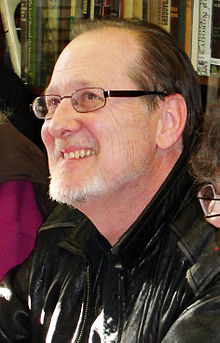
John Shirley has written novels, short stories, TV scripts, screenplays, song lyrics, poetry, and various forms of nonfiction. His books number more than eighty, including numerous novels of sf, dark fantasy, horror, thrillers, and westerns, and twelve short story collections. He has won the Bram Stoker Award for his collection: Black Butterflies: A Flock on the Dark Side, and the Spur Award for his Western Gunmetal Mountain. He has also written one non-fiction book, Gurdjieff: An Introduction to His Life and Ideas. As a musician, Shirley has fronted his own bands and written lyrics for Blue Öyster Cult and others.
John Shirley currently lives in Vancouver, Washington, with his wife, Micky Shirley. He has three adult sons: twins Byron and Perry and their younger brother Julian. Byron is a yacht captain and yacht broker; Perry is a journalist, teacher, and artist. Julian is a Bay Area-based underground rapper and producer of hip-hop, trap, chiptune, and various other electronic music genres as well as a professional computer technician. He is also known as Juji or Young Bios.
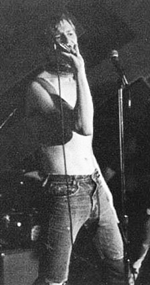
John Shirley was born in Houston, Texas, but grew up largely in the Portland, Oregon, area.
During the 1980s, continuing to publish novels, he pursued a career as a musician while living in New York City and Paris, France. Shirley fronted the post-punk funk-rock band Obsession and recorded for Celluloid Records. He was in the band The Panther Moderns during the mid-nineties to early oughts with John Karr on the guitar and keyboards, Mike Deery on bass, and other guest musicians. They issued the album Red Star in 1997.
The double album Broken Mirror Glass: The Anthology 1978-2012 was issued in 2013 by Infrarot and includes thirty songs—in chronological order—from more than three decades of musical work by Shirley.
Another 2013 album, John Shirley and His Criminal Accomplices, offers seventeen songs from the same period. (It is available on iTunes.) His most recent band is the Screaming Geezers.
His lyric credits for other bands include eighteen songs recorded by Blue Öyster Cult.
[See Music for more]
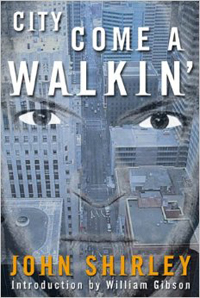
Shirley's earliest novels were Transmaniacon (sf, 1979) and Dracula In Love (horror, 1979). His third novel, the proto-cyberpunk City Come A-Walkin' (1980), provided William Gibson with the precursors "both of sentient cyberspace and of the AIs in Neuromancer" not to mention mirrorshades and a "post-punk milieu...cp to the max, neatly pre-dating Bladerunner." He also wrote the A Song Called Youth cyberpunk trilogy of Eclipse (1985), Eclipse Penumbra (1988), and Eclipse Corona (1990). The trilogy has been re-released by Dover Books and as ebooks by Open Road Media.
Other early novels include the suspense thriller The Brigade, the surrealistic A Splendid Chaos, and Three-Ring Psychus (re-written and re-issued in 2014 as High). Cellars (1982) and In Darkness Waiting (1988) have become horror classics, as has Wetbones (1991) ("John Shirley is an adventurer, returning from dark and troubled regions with visionary tales to tell. Wetbones is a wild and giddy ride, confronting the reader with marvels and horror in equal measure."— Clive Barker)
His science fiction novel Silicon Embrace ("Thrills and spills, with plenty of encouragement for armchair UFO-conspiracy enthusiasts."—Kirkus) was published in 1996.
His first collection of short stories, Heatseeker (Scream, 1989), was published to high praise. Black Butterflies: A Flock on the Darkside (first published: Mark V. Ziesing, 1998) and Really Really Really Really Weird Stories (Night Shade Books, 1999) garnered both critical kudos and further popular acclaim. Publishers Weekly named Black Butterflies as one of the "Best Books of 1998." It also won both the Bram Stoker Awards and the International Horror Guild Award for Outstanding Collection.
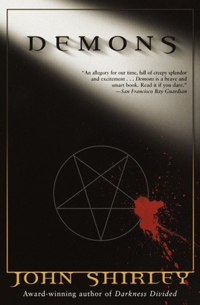 Demons (originally published as a limited edition novella by Cemetery Dance Publications
in 2000) was republished in a new version with a second novella, Undercurrents, in hardcover
by Del Rey (2002) and trade paperback in 2003. Although several of his novels can be considered
cult classics, Demons became a cult phenomenon, still selling over fifteen years later.
Demons (originally published as a limited edition novella by Cemetery Dance Publications
in 2000) was republished in a new version with a second novella, Undercurrents, in hardcover
by Del Rey (2002) and trade paperback in 2003. Although several of his novels can be considered
cult classics, Demons became a cult phenomenon, still selling over fifteen years later.
His creative skill at adaptation has led him to craft numerous novelizations and tie-in novels for films, television series, comic universes, and games. The most notable of these include bestsellers BioShock: Rapture (2011) and Halo: Broken Circle (2014).
His most recent longer original fiction includes urban occult fantasy Bleak History (2009); noir-flavored novel of apocalypse, Everything Is Broken (2010); New Taboos (which combined fiction and nonfiction; 2013); Doyle After Death (2014), a supernatural mystery featuring the master detective Sir Arthur Conan Doyle; and his historical novel about Wyatt Earp, Wyatt in Wichita (2014). New short stories and novellas continue to appear in top genre magazines and anthologies; several have been reprinted in The Year's Best Dark Fantasy & Horror series.
Additional collections of short fiction include: Darkness Divided (2001), Living Shadows: Stories: New and Pre-Owned (2007), and In Extremis: The Most Extreme Stories of John Shirley (2011). Lovecraft Alive! (2016) collects his short stories directly inspired by H. P. Lovecraft. His newest story collection is The Feverish Stars.
[See Books for a complete list and links to individual titles]
Shirley's best known screenwriting is the film The Crow, for which he was the initial writer with five drafts, before David Schow was brought on. He also wrote scripts for Star Trek: Deep Space Nine, Poltergeist: The Legacy, VR.5, and other TV series. Shirley has penned quite a few episodes of animated television series, too. In 2014 he was nominated for a Primetime Emmy Award for Outstanding Animated Program.
 John Shirley gained his initial authorial reputation as a cyberpunk
author. (Simplistically: "A genre of science fiction set in a lawless
subculture of an oppressive society dominated by computer technology."—Oxford Dictionaries; or, even more succinctly, "high tech, low life.")
Initially, before the label was applied, Bruce Sterling wrote (in 1986) that "cyberpunk" was
simply "'the Movement'—a loose generational nexus of ambitious young writers,
who swapped letters, manuscripts, ideas, glowing praise, and blistering criticism.
These writers—[William] Gibson, [Rudy] Rucker, [Lewis] Shiner, [John] Shirley, [Bruce]
Sterling—found a friendly unity in their common outlook, common themes, even in certain
oddly common symbols, which seemed to crop up in their work with a life of their own."
John Shirley gained his initial authorial reputation as a cyberpunk
author. (Simplistically: "A genre of science fiction set in a lawless
subculture of an oppressive society dominated by computer technology."—Oxford Dictionaries; or, even more succinctly, "high tech, low life.")
Initially, before the label was applied, Bruce Sterling wrote (in 1986) that "cyberpunk" was
simply "'the Movement'—a loose generational nexus of ambitious young writers,
who swapped letters, manuscripts, ideas, glowing praise, and blistering criticism.
These writers—[William] Gibson, [Rudy] Rucker, [Lewis] Shiner, [John] Shirley, [Bruce]
Sterling—found a friendly unity in their common outlook, common themes, even in certain
oddly common symbols, which seemed to crop up in their work with a life of their own."
William Gibson emerged as—by far—the best known and best selling of the group after his debut novel, Neuromancer (1984). Considered as a highly radical work at the time, it became known as the quintessential cp novel.
In Gibson's introduction to Shirley's novel City Come A-Walkin', however, he acknowledges John Shirley as "...cyberpunks' Patient Zero, first locus of the virus, certifiably virulent." City Come-Walkin' provided Gibson with the precursors "both of sentient cyberspace and of the AIs in Neuromancer" not to mention mirrorshades and a "post-punk milieu...cp to the max, neatly pre-dating Bladerunner."
Bruce Sterling has cited Shirley's debut collection Heatseeker as being a seminal cyberpunk work in itself. He considers the story "Sleepwalkers", as an example, as the probable inspiration for Gibson's "meat puppets" in Neuromancer. He dubbed the A Song Called Youth trilogy a "complex, bizarre, and unique vision of the near future, with a kaleidoscopic mix of politics, pop, and paranoia."
Jason McGregor, Nerds of a Feather, Flock Together, wrote, in retrospect, of the trilogy:
It is difficult with Shirley in general, and with this sequence in particular, to accurately assess its legacy. Shirley never seems to have had the impact of a Gibson on mass-consciousness but is an influencer of the influencers, so to speak. However well- or little-known, it is probably Shirley's best known work and certainly merits being widely known... In many ways, this is quintessential cyberpunk but, in many ways, Shirley (as he so often does) blazes his own trail. Unlike the stereotypical image of cyberpunk, he sets this story in Europe rather than Asia; focuses on military more than corporate matters; and has a space presence in addition to a ground-based computer focus.
Transputer Qasar considered the "Eclipse trilogy" as "one of the finest examples of cyberpunk 'war' novels available. A mesmerizing dark future setting, coherent intrigue, heavy-duty warfare and lots of characters you care for..."
 A reviewer for NCRP stated: "Eclipse, Eclipse Penumbra, and Eclipse Corona are probably the most incredible
cyberpunk stories I've read to date. Throughout the three books, as the years progress, so does the technology.
In most series, the technology is absolutely stagnant. Shirley has done an incredible job at creating a story
that will driveyou to read on and on with desperation as you come to the end of the secondbook. If you want to see how to write cyberpunk, this is the series.
A reviewer for NCRP stated: "Eclipse, Eclipse Penumbra, and Eclipse Corona are probably the most incredible
cyberpunk stories I've read to date. Throughout the three books, as the years progress, so does the technology.
In most series, the technology is absolutely stagnant. Shirley has done an incredible job at creating a story
that will driveyou to read on and on with desperation as you come to the end of the secondbook. If you want to see how to write cyberpunk, this is the series.
Shirley was the only punk rocker writing science fiction. Music was as important as writing. What might be considered gossipy titillation or private personal information about another writer, is essential knowledge when considering the works and career of John Shirley. His peers imagined dark and gritty futures while maintaining an even keel in their lives; Shirley had no keel to keep even.
As Shirley has explained: "I had no understanding of professionalism. I had no social graces... I was childishly manipulative—and, worse, clumsy at trying to manipulate people—people winced at my swaggering; but I wasn't a cowardly, colorless nerd either. The thing is I really did come from the streets, so where I came from it was right and natural to say anything to try to hustle something up. Truth or lies, it was all the same because you were trying to hustle the squareheads. I had punk damage, too, and thought that doing things professionally was selling out or something... I switched from abusing psychedelics (which I never wrote on; I never wrote while on any drug) to abusing harder narcotics."
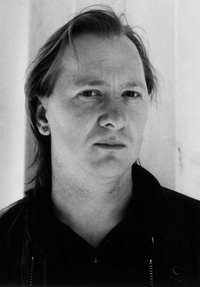 Shirley eventually got sober,
something he's maintained for decades now, and became a
responsible parent and husband. But his experiences "put some pretty dark glasses" on him. "I saw the dark
side, more and more. But then that side is real: It's a dark goddamn world. Maybe I call
attention to the dark side a little bit for mutual
catharsis, but also to try to paint the universe as it is—both sides
of it. A painter like Goya, say, who paints things dark: does that mean
his paintings are not beautiful? Art (not saying I'm a real artist, only
want to be) transcends dark or light, it just paints truth and in its
gemlike objectivity makes any truth gorgeous, even the nightmarish ones."
Shirley eventually got sober,
something he's maintained for decades now, and became a
responsible parent and husband. But his experiences "put some pretty dark glasses" on him. "I saw the dark
side, more and more. But then that side is real: It's a dark goddamn world. Maybe I call
attention to the dark side a little bit for mutual
catharsis, but also to try to paint the universe as it is—both sides
of it. A painter like Goya, say, who paints things dark: does that mean
his paintings are not beautiful? Art (not saying I'm a real artist, only
want to be) transcends dark or light, it just paints truth and in its
gemlike objectivity makes any truth gorgeous, even the nightmarish ones."
His short stories from the nineties were dark—sometimes bleak, but often wickedly humorous—a new kind of horror. Stories based in the very real world with indelible characters facing moral dilemma or dealing with their obsessions. Other stories—surreal, supernatural, coming from some strange nightmare reality.
![]() Wetbones, a novel published by an independent press Mark V. Ziesing in 1991,
was, according to Shirley, "about addictiveness in general, narcotics and other kinds,
kind of melded with the decadent Hollywood scene and even some Lovecraftian imagery.
It came out of a lot of pain and caustic remorse."
Wetbones, a novel published by an independent press Mark V. Ziesing in 1991,
was, according to Shirley, "about addictiveness in general, narcotics and other kinds,
kind of melded with the decadent Hollywood scene and even some Lovecraftian imagery.
It came out of a lot of pain and caustic remorse."
He returned to science fiction with Silicon Embrace (again published by Ziesing) in 1996. The author considered it as "a transitional book, incorporating cyberpunk, but attempting to build a bridge to a greater awareness of life, a bridge to metaphysical, philosophical issues. I was trying to bring people to this in whatever way I could—narrative, humor, satire, fun with conspiracy and paranoia, social issues—to draw them into what seems to me higher questions.... In my books ideas, concepts, are themselves metaphors."
His earliest collections—Heatseeker and New Noir, respectively—gathered some of his edgier SF and literate noir. Black Butterflies: A Flock on the Darkside (Mark V. Ziesing, 1998) collected some of his dark fiction.
Publishers Weekly, in a starred review said of the collection:
Shirley has a reputation for being one of the edgiest, boldest writers around—a reputation that will only be enhanced by this first-rate and fierce collection...laid down in adrenalized, jivey, yet extremely artful prose that fairly skids across the page, dragging the reader along with it into shadowed corners of terror and desire. Yet while it's thrilling, there's psychological depth in it, too, as Shirley bores into the brains of his characters, revealing the motivations of those who walk on the wild side. Shirley loses nothing when he moves toward the fantastic...Here, as throughout this blade of a book, Shirley casts a story in which the veil of normalcy and habit is ripped away and his characters, and readers, are invited to behold the fundamental mystery of life.
Later, when PW named Black Butterflies as one of the Best Books of 1998, it noted:
As demonstrated by this bold and innovative short story collection, few writers—if any—handle SF, dark fantasy and psychological horror alike with as much panche as Shirley. But there's depth beneath the scintillating surface, as Shirley plumbs not just the minds but also the souls of those who walk on the wild side.
Shirley's earlier dark novels had, like his science fiction, more of an influence on other writers than an immediate effect on the public at large.
The author has described Dracula in Love (1979) as starting "with Vlad the Impaler in modern times—you find out about this tragedy in his life that propels him into vampirism. He's at war with God... a vampire novel which must have totally baffled most vampire novel fans." Nancy Collins has said the novel's unorthodox vampirism helped inspire her protagonist Sonja Blue.
 In 1988, William Gibson assessed Shirley's novel
Cellars (1982) as "relentless over-the-top
horror-baroque" that "brings Clive Barker to mind. It reads like Lovecraft on PCP.
In 1982, there was nothing quite like it." Edward Lee saw Cellars as "a progenitor to a
good-sized pie wedge of the horror market in 2006. Some books are timeless, immune to
fading from their original creative luster, and Shirley's early masterpiece of the form
is one such endeavor....The bottom line is this: One of the very first hardcore horror novels
truly remains [in 2006] one of the very best, even after two and a half decades."
In 1988, William Gibson assessed Shirley's novel
Cellars (1982) as "relentless over-the-top
horror-baroque" that "brings Clive Barker to mind. It reads like Lovecraft on PCP.
In 1982, there was nothing quite like it." Edward Lee saw Cellars as "a progenitor to a
good-sized pie wedge of the horror market in 2006. Some books are timeless, immune to
fading from their original creative luster, and Shirley's early masterpiece of the form
is one such endeavor....The bottom line is this: One of the very first hardcore horror novels
truly remains [in 2006] one of the very best, even after two and a half decades."
Critic Rick Kleffel wrote of In Darkness Waiting (1988) Using many of the tropes of 1980's horror, it's an intelligent, intellectual piece of literary science fiction horror and definitely not one of the many "terror in a small town" novels that exploded off the shelves in the 1980s, often injuring unsuspecting passers-by.
Demons (originally released as a hardcover limited edition novella by Cemetery Dance, 2000; expanded with an additional novella and published by Del Rey in 2002) has attained true cult status gaining a wide readership that may or may not be aware of his role as the godfather of cyberpunk
Publishers Weekly, said of the novella:
Horror fiction that traffics in the supernatural perforce sometimes deals with matters of psycho-spiritual import. Rarely does it tackle them as directly as in this exciting, vigorously original novella...The book is brief, but Shirley packs into it an epic's worth of imagination and ideas...With its potent underlying philosophy, serious theme, fresh vision and taut storytelling, this little novel makes a big impact.
Appreciation of John Shirley as an author of dark fiction was amplified by a January 2008 The New York Times review, by critic Terrence Rafferty, of Shirley's story collection Living Shadows: Stories: New & Preowned which said in part:
It's a greatest-hits album spanning a few decades of astonishingly consistent and rigorously horrifying work. . . Shirley's great subject is the terrible ease with which we modern Americans have learned to look away from pain and suffering. The opening line of his novel Demons states the theme succinctly: "It's amazing what you can get used to." ...Maybe the best story in this superb collection is a rapt little piece called "Skeeter Junkie," in which a young heroin addict first begins to enjoy the feeling of the mosquito feeding on his arm, then starts to identify with it and then, as the drugs ooze through his veins, somehow becomes it and finally uses the "exquisite" flying bloodsucker to transport him to the apartment of his comely but standoffish downstairs neighbor. It's a horror story, I guess, but it's also funny, weirdly erotic and, in a way that horror almost never is, tragic.
 Shirley's intent in using the visceral and sexual in horror was to entertain while (in his words) "expressing metaphorically
or directly something true and new about the human condition, or reveal something happening in some dark corner of the world
that, like it or not, we need to shine light into." In most of his works, the author
is also exploring a philosophy, pursuing a socio-political agenda, and/or delving into the spiritual and metaphysical.
John Shirley may well be, as Larry McCaffery dubbed him, "the postmodern Poe," but many current writers who cite him as
an influence, however, often utilize the graphic and shocking aspects without emulating the layers of meaning that are the essence of Shirley's work. Like Poe,
it may take time for John Shirley's literary achievements to be fully appreciated
Shirley's intent in using the visceral and sexual in horror was to entertain while (in his words) "expressing metaphorically
or directly something true and new about the human condition, or reveal something happening in some dark corner of the world
that, like it or not, we need to shine light into." In most of his works, the author
is also exploring a philosophy, pursuing a socio-political agenda, and/or delving into the spiritual and metaphysical.
John Shirley may well be, as Larry McCaffery dubbed him, "the postmodern Poe," but many current writers who cite him as
an influence, however, often utilize the graphic and shocking aspects without emulating the layers of meaning that are the essence of Shirley's work. Like Poe,
it may take time for John Shirley's literary achievements to be fully appreciated
Cyberpunk has, of course, had a cultural influence beyond that of "saving science fiction." Its moment may have passed or we may be living it; either way, Shirley was essential in its emergence.
Although the final film was far from John Shirley's initial or sole concept, he must at the very least be credited with recognizing James O'Barr's work and his contributions to The Crow. Despite the tragedy of Brandon Lee's death, the film received strong reviews and became franchise-spawning worldwide phenomenon. The Crow was a defining film of the nineties and influenced many later films. It launched director Alex Proyas's career as a mainstream filmmaker, and remains—despite unwatchable sequels—a cult favorite.